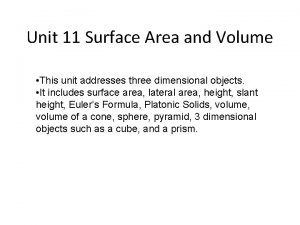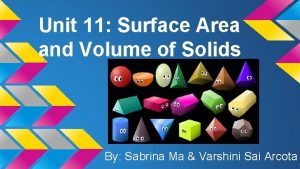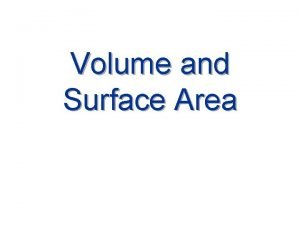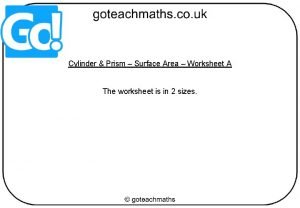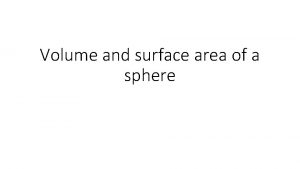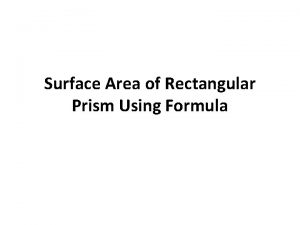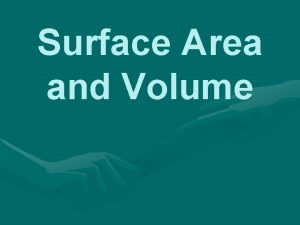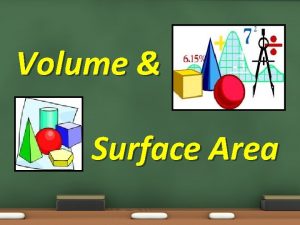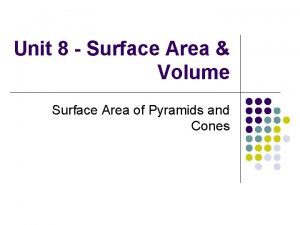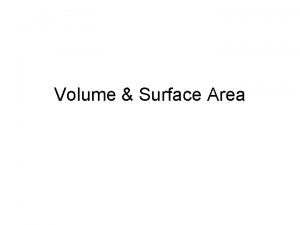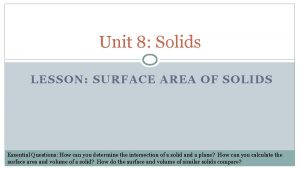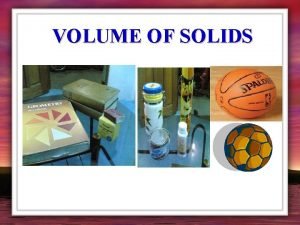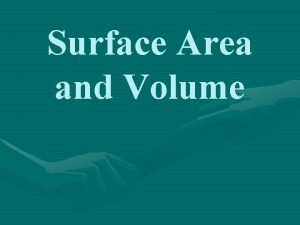Unit 11 Surface Area and Volume of Solids









- Slides: 9

Unit 11: Surface Area and Volume of Solids By: Sabrina Ma & Varshini Sai Arcota

Key Concepts ● ● ● ● Surface Area: sum of area of all faces of a solid Bases: two parallel and congruent faces of a solid Lateral Faces: non-bases of a solid Lateral Area: sum of areas of lateral faces of a solid Volume: how much space a solid takes up Polyhedra: solid with flat faces that are polygons Prism: polyhedra with two congruent parallel faces and rectangular sides

Formulas Surface Area: Volume: ● Prism: add areas of all sides ● Cylinder: 2πrh+2πr² LA: 2πrh ● Cone: πrl+πr² LA: πrl ● Sphere: 4πr² (area of base • height) ● ● ● Prism: l • w • h Cylinder: πr² • h Cone: ⅓πr² • h Pyramid: ⅓B • h Sphere: (4/3)πr³

Example #1 LA: 2πr • h Find the 2π4 • 9= 72π lateral area, SA: 2πr • h + 2πr² surface area 2π4 • 9 + and volume: 2π(4)² 4 9 72π + 32π 104π V: B • h 16π • 9=144π How will finding lateral area help you with surface area? Since the lateral area is part of the entire surface area, you just have to add the area of the bases to the lateral area to find the surface area.

Example #2 Find the surface area and volume: SA: ½(4πr²)+2πrh+πr² 2π(6)²+2π6 • 8+π(6)² 72π+96π+36π=204π half-sphere 8 cylinder 6 V: ½(⁴/3πr³)+πr²h ⅔π(6)³+π(6)² • 8 144π+288π=432π

Example #3 Find the volume: x y 8 x+10 12+8 x(12+8)=12(x+10) 20 x=12 x+120 8 x=120 x=15 Radius of cones’ bases: ►Pythagorean Theorem 12 Frustum x = ____ 12 _____ 10 z Volume of frustum= Volume of smaller cone subtracted from volume of bigger cone 12²+y²=15² 144+y²=225 y²=81 y=9 (12+8)²+z²=(15+10)² 20²+z²=25² 400+z²=625 z²=225 z=15 Vol of cone: B • h or πr² • h Small cone: π(9)² • 12 81π • 12 972π Large cone: π(15)² • 20 225π • 20 4500π Frustum: 4500π-972π 3528π

Common Mistakes ● forgetting to add or subtract sides when finding surface area ● forgetting to figure out the volume for a part of the shape (ex: the half-sphere on a ice cream cone) ● adding x and x√ 3 or x and xπ ● using wrong formulas for different solids ● forgetting parts of the formula when doing work

Connections to Other Units ● Unit 11 connects to Unit 10 is about finding areas of shapes o Solids are made of shapes, so knowledge of Unit 10 will help find surface areas of solids for Unit 11 o Unit 10 will also help find area of base to find volume ● This unit is also connected to Unit 7 is about finding the area and leg lengths of triangles o Many solids contain triangular faces (prisms and pyramids), therefore knowing how to get the area of a triangle is very important o Often times, the triangle can be a base, so you want to be able to find the surface area and volume of the object

Real Life Example A company wants to make a can for a drink. Figure out, to the nearest whole number, how much liquid can fill the inside of the can, and how much material is used to make the can. 14 cm 16 cm SA: 2πr • h + 2πr² 2π7 • 16 + 2π(7)² 224π + 98π 322π or 1012 cm² V: B • h or πr² • h π(7)² • 16 49π • 16 784π or 2463 cm³


